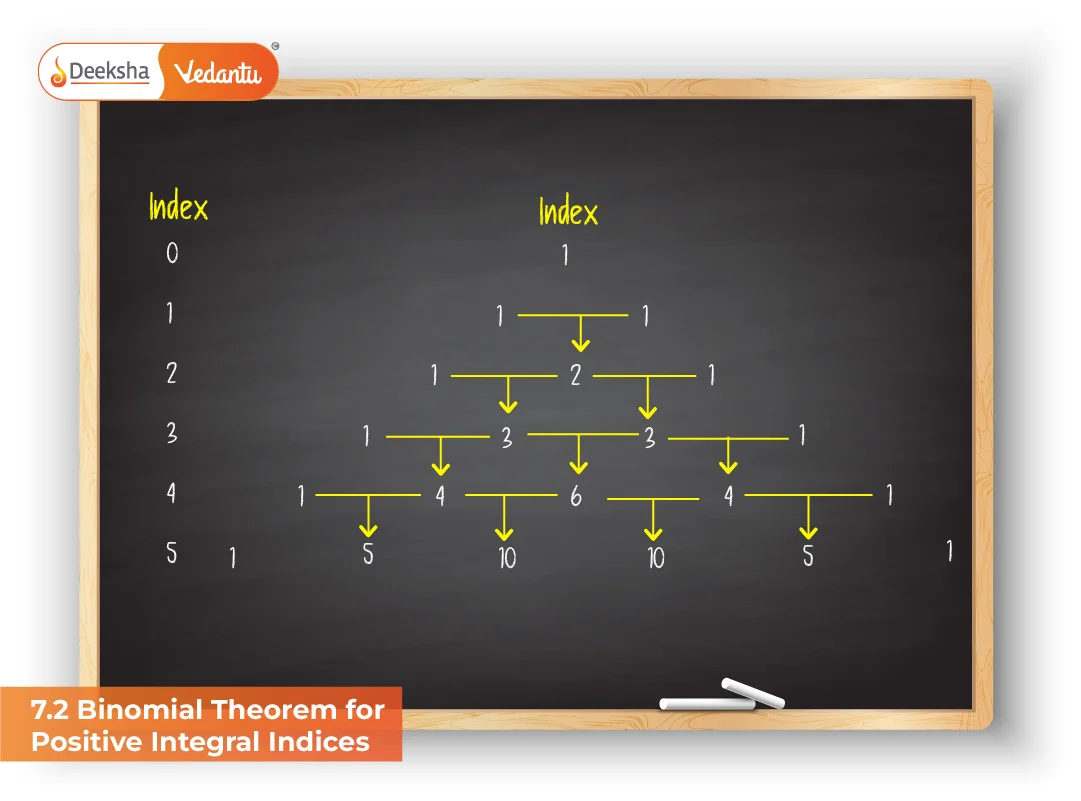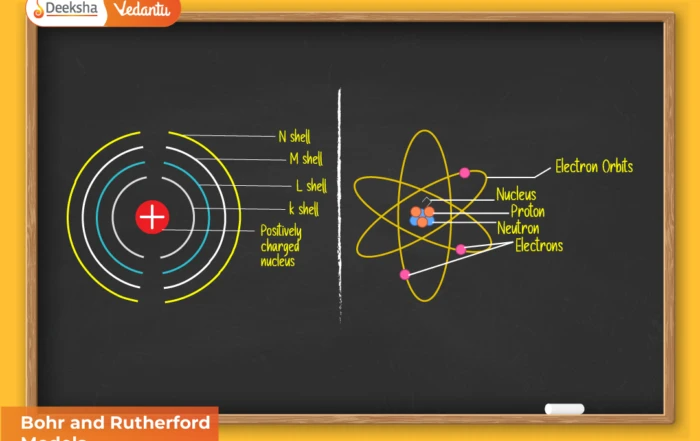
Introduction
The Binomial Theorem for Positive Integral Indices is the core result of the binomial theorem. It provides a formula to expand expressions like:
(a + b)ⁿ, where n is a positive integer (n ∈ N).
Instead of multiplying the binomial repeatedly, the theorem allows us to directly write down the expanded form using binomial coefficients.
This makes it a powerful tool for:
- Expansions in algebra
- Solving coefficient-related questions in exams
- Approximation problems in physics and engineering
- Probability theory (Binomial distribution)
Statement of the Theorem
For a positive integer n:
(a + b)ⁿ = Σ (nCr) a(n–r) br, where r = 0, 1, 2, …, n.
Expanded form:
(a + b)ⁿ = nC0 aⁿ + nC1 a(n–1)b + nC2 a(n–2)b² + … + nCr a(n–r)br + … + nCn bⁿ
Explanation
- nCr = n! / [r!(n – r)!] is the binomial coefficient.
- Each term has the form:
T(r+1) = nCr a(n–r) br - Total terms = n + 1.
- Powers of a start from n and decrease to 0.
- Powers of b start from 0 and increase to n.
Example Expansion
Expand (x + y)⁴:
(x + y)⁴ = 4C0 x⁴ + 4C1 x³y + 4C2 x²y² + 4C3 xy³ + 4C4 y⁴
= x⁴ + 4x³y + 6x²y² + 4xy³ + y⁴
Derivation of the Theorem
Step 1: Understanding patterns
Multiply (a + b) × (a + b) × (a + b) … n times.
Each term of the expansion comes from choosing either ‘a’ or ‘b’ from each bracket.
Step 2: Counting terms with exactly r b’s
- To form a term with r b’s, we choose r brackets (out of n) to contribute ‘b’.
- The remaining (n – r) brackets contribute ‘a’.
- Total ways = nCr.
Step 3: General term
Hence, a term with r b’s = nCr a(n–r) br.
Step 4: Full expansion
By summing over r = 0 to n,
(a + b)ⁿ = Σ nCr a(n–r)br
Proven!
Properties of the Expansion
- Number of terms: n + 1
- First term: aⁿ
- Last term: bⁿ
- General term: T(r+1) = nCr a(n–r)br
- Symmetry of coefficients: nCr = nC(n – r)
- Sum of coefficients: (1 + 1)ⁿ = 2ⁿ
- Alternating sum of coefficients: (1 – 1)ⁿ = 0
Special Cases
- When b = 1: (a + 1)ⁿ expansion gives coefficients directly.
- When a = 1: (1 + b)ⁿ expansion is widely used in approximations.
- When a = 1, b = –1: (1 – 1)ⁿ = 0 → useful in proofs.
Step-by-Step Solved Examples
Example 1: Expand (x + y)³
(x + y)³ = x³ + 3x²y + 3xy² + y³
Example 2: Find the coefficient of x⁵ in (1 + x)¹²
General term = nCr xr
Coefficient of x⁵ = 12C5 = 792
Example 3: Find the middle term(s) in (a + b)⁸
n = 8 → middle term = (8/2 + 1)th = 5th term
T5 = 8C4 a⁴ b⁴ = 70a⁴b⁴
Example 4: Find the 7th term in (2x – 3)¹⁰
General term = nCr a(n–r)br
Here n = 10, a = 2x, b = –3
7th term → r = 6
T7 = 10C6 (2x)⁴ (–3)⁶
= 210 × 16x⁴ × 729
= 2449440x⁴
Example 5: Find the sum of coefficients in (x – 2)⁵
Sum of coefficients = (1 – 2)⁵ = (–1)⁵ = –1
Example 6: Find constant term in (x² + 1/x)⁶
General term = 6Cr (x²)(6–r) (1/x)r = 6Cr x(12 – 3r)
For constant term: 12 – 3r = 0 → r = 4
T5 = 6C4 = 15
Example 7: JEE Style – Approximation
Approximate (1.01)⁵ up to 3 decimals.
(1 + 0.01)⁵ = 1 + 5(0.01) + 10(0.01)² + …
≈ 1 + 0.05 + 0.001 = 1.051
Example 8: KCET Style – Find coefficient of x³ in (1 + 2x)⁶
Required term → r = 3
Coefficient = 6C3 (2)³ = 20 × 8 = 160
Example 9: COMEDK Style – Show that sum of coefficients of even powers of x in (1 + x)ⁿ = 2(n–1)
(1 + x)ⁿ = f(1) = 2ⁿ
(1 – x)ⁿ = f(–1) = 0 → difference separates odd and even terms
Sum of even coefficients = (f(1) + f(–1))/2 = 2(n–1)
Exam-Oriented Applications
In Boards (CBSE, State):
- Direct expansions (4–5 marks)
- Middle term or general term problems
- Coefficient-based questions
In JEE Main:
- Coefficient of xr in expansions
- Identifying terms using substitution\
- Approximation problems
In KCET / COMEDK:
- One-step coefficient or term problems
- Constant term / middle term
In JEE Advanced:
- Proofs of identities using expansions
- Advanced manipulations with symmetry
Marks Weightage
- CBSE Boards: 6–8 marks
- JEE Main: ~4 marks
- KCET / COMEDK: 4–6 marks
- JEE Advanced: Indirect but conceptual
Common Mistakes
- Forgetting that r = term number – 1.
- Confusing coefficient with full term.
- Ignoring negative signs of b.
- Mixing middle term formula when n is odd vs even.
- Using wrong approximation order.
Practice Problems
- Expand (a – b)⁶.
- Find coefficient of x⁷ in (1 + x)¹².
- Find middle term(s) in (1 – x)¹⁵.
- Find a constant term in (x + 1/x)¹⁰.
- Approximate (1.02)¹⁰ up to two decimals.
- Show that coefficient of xⁿ in (1 + x)²ⁿ = (2nCn).
- Find ratio of sum of odd coefficients to even coefficients in (1 + x)¹⁰.
- Prove that sum of coefficients in (1 – 1)ⁿ = 0.
FAQs
Q1. What is the general term in binomial expansion?
T(r+1) = nCr a(n–r) br
Q2. How to identify middle term(s)?
- If n is even → single middle term at (n/2 + 1)
- If n is odd → two middle terms at ((n+1)/2) and ((n+3)/2)
Q3. How to find the coefficient of a term?
Extract the required power of x and evaluate binomial coefficient.
Q4. Can this theorem work for fractional powers of n?
Not in this section. That’s Newton’s Generalized Binomial Theorem (covered later).
Final Summary
The Binomial Theorem for Positive Integral Indices gives a direct formula to expand (a + b)ⁿ.
- It introduces the general term formula T(r+1) = nCr a(n–r)br.
- Applications include coefficients, middle terms, approximations, and proofs.
- This section is heavily tested in Boards, JEE, KCET, and COMEDK, making it one of the most high-scoring topics in Algebra.











Get Social